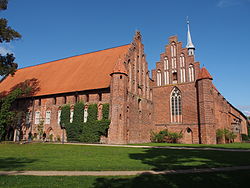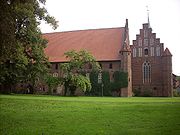Wienhausen Monastery
| Wienhausen Monastery | |
|---|---|
 Exterior view: left monastery building, right monastery church with the nuns' choir |
|
| location |
Lower Saxony |
| Coordinates: | 52 ° 34 '50.7 " N , 10 ° 11' 6.1" E |
| founding year |
1230 (since 1528 Evangelical Lutheran women's monastery) |
The Wienhausen Abbey - a former Cistercian monastery , now a Protestant nunnery - dates back to the 13th century. It is located in Wienhausen in Lower Saxony and is administered by the Hanover Monastery Chamber.
description
The historical monastery ensemble has largely been preserved. To the east of the church are the watermill and farm buildings. The convent buildings are attached to the church at right angles to the north : the medieval in the west and the post - Reformation half - timbered building in the east; in between the two-storey cloister in the style of brick Gothic . The church consists of the old Romanesque Archdeaconate Church (whose tower was demolished when the monastery was founded according to the Cistercian rule) and the high Gothic monastery church with the nuns' choir on the upper floor and the pilgrim hall on the ground floor. The two parts of the building are now separated by a wooden wall and are used separately.
The nuns' choir, completed in the 14th century, is one of the most remarkable preserved Gothic sacred rooms. The ceiling and walls are painted with biblical pictures and ornaments. The story of creation, the life and death of Jesus Christ and his resurrection and reign in the heavenly Jerusalem are depicted . When the oak planks under the nuns' stalls were removed in 1952 to lay electrical cables, rare and valuable everyday objects were found, including riveted glasses from the 14th and 15th centuries, as well as items that can be ascribed to both Christian and pagan cult .

2. Monastery church
3. Parish church St. Marien
4. Abbess apartment
5. Newer apartments for conventuals
6. Monastery servants apartment
7. Adjoining building
8. Front courtyard
9. Smaller monastery courtyard
10. Larger monastery courtyard
11. Back courtyard
12. Gardens
13. Pale
14 Monastery woods
15. Apartment and outbuildings of the clerk
16. Bell house
Wienhausen Abbey is known for its collection of valuable Gothic tapestries from the 14th and 15th centuries, which can be seen in a special exhibition every year from the Friday after Whitsun. The carpets show both Christian and secular motifs; For example, the Tristan announcement , various stories of saints (Thomas, Anna and Elisabeth) and the mirror of human salvation are shown . The conventual women living in the monastery look after the numerous art treasures and offer guided tours. Since 2000, the carpets and the finds from the nuns' choir can be viewed with multilingual audio tours (German, English, French and Spanish) during the main season . Guided tours through the monastery are also available in English, French, Spanish and Low German on request.
history
The monastery was founded around 1230 by Agnes von Landsberg about 15 kilometers from Celle in Wienhausen an der Aller . According to the Wienhausen Chronicle, there was already a monastery a few kilometers away, which was then moved to Wienhausen because of its location in a swampy area. However, this cannot be proven with certainty.
In 1233 the founding of the monastery in Wienhausen was officially confirmed by Bishop Konrad II and the archdeaconate church, which had been located there since the middle of the 11th century, was given to him with all property and tithes in several villages. The nuns in the monastery lived according to the rules of the Cistercians .
From 1528, Duke Ernst von Braunschweig-Lüneburg introduced the Reformation in his duchy. The monastery was - against the resistance of the nuns - transformed into an Evangelical Lutheran women's convent. In 1531 the duke broke the resistance of the Catholic nuns by demolishing the provost house and all chapels (with the exception of the All Saints' Chapel ) and moving in the provost property. The destroyed buildings were rebuilt 19 years later in half-timbered style. In 1555 the Lüneburg monastery order was issued. In 1587 the first evangelical abbess was officially installed.
It is reported that Catholic services were held clandestinely for many years.
See also
literature
- Horst Appuhn: Kloster Wienhausen (= North German work monographs ). With 80 plates based on photos by Hans Grubenbecher. Ellermann, Hamburg 1955.
- Horst Appuhn: Wienhausen Monastery. Recordings by Hans Grubenbecher, Dietrich Klatt and Jens Rheinländer. Wienhausen Monastery, Wienhausen 1986, ISBN 3-9801316-0-2 .
- Ernst Andreas Friedrich : The Wienhausen Monastery. In: Ernst Andreas Friedrich: If stones could talk. Volume 4. Landbuch-Verlag, Hannover 1998, ISBN 3-7842-0558-5 , pp. 145-147.
- Charlotte Klack-Eitzen, Wiebke Haase, Tanja Weißgraf (eds.): Holy skirts. Dresses for sculptures in Kloster Wienhausen. Schnell + Steiner, Regensburg 2013, ISBN 978-3-7954-2701-6 .
Web links
- Website of the Wienhausen Monastery
- Pictures from the monastery
- Description of Wienhausen Monastery on the Lower Saxony monastery map of the Institute for Historical Research
- Legends from Lower Saxony - The origin of the Wienhausen monastery in the Gutenberg-DE project




